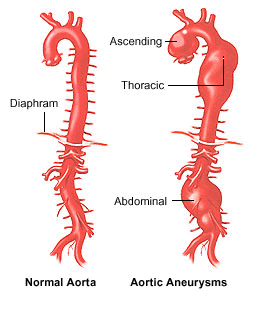The abdominal aorta is the largest blood vessel in the body and the main artery stemming from the heart. An abdominal aortic aneurysm (AAA) is an enlargement in the lining of a blood vessel caused by a breakdown of the lining of the vessel. As the lining gets weaker, primarily due to age and other risk factors, the vessel wall becomes thinner and expands.
Medical research indicates that as many as 8 out of every 100 people over the age of 60 have an undetected AAA. An aneurysm can rupture, producing catastrophic bleeding and, in 90-95 percent of people, death.
Risk factors
• Hardening of the arteries (arteriosclerosis)
• Smoking
• Gender (male)
• Hypertension
• Family history
The vast majority of persons with AAA have no symptoms
How we can help…
Abdominal Aortic Aneurysms can be easily detected by ultrasound examination, but are relatively difficult to detect by physical examination. The AAA screen detects the existence of an aneurysm or enlargement in the abdominal aorta through ultra-sound visualization.

